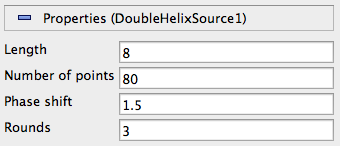

- #Paraview python programmable filter tutorial install
- #Paraview python programmable filter tutorial update
- #Paraview python programmable filter tutorial software
AddProxyLink ( proxy1, proxy2, linkName = '', link = None ) ¶Ĭreate a link between two proxies and return its name.Īn instance of a vtkSMProxyLink subclass can be given, otherwise Makes a new vtkLight and adds it to the designated or active view. Name already exists it will be removed first. So that the link can be referred to by name. AddCameraLink ( viewProxy, viewProxyOther, linkName = '' ) ¶Ĭreate a camera link between two view proxies. Show ( shrink ) # Render the scene Render () paraview.simple. sphere = Sphere ( ThetaResolution = 16, PhiResolution = 32 ) # Apply a shrink filter shrink = Shrink ( sphere ) # Turn the visibility of the shrink object on. It’s almost as useful to see the highest principal value of the stiffness, as a scalar or a vector.From paraview.simple import * # Create a new sphere proxy on the active connection and register it # in the sources group. But it’s a lot more work to produce, especially with nonlinear materials.

This dataset is useful for checking input data for anisotropic materials, as well as for the stuff with inverse design of fields of this tensor. Easiest for the paraview user would be to provide it in the (deflected) global cartesian frame. Include an integer scalar containing each element’s GROUP or MATERIAL.Īdd element’s material tangent stiffness tensor. Use CCXStressReader.Ĭontribute to meshio. Read DAT files: it would be a killer feature if Paraview could visualize results in Gauss points. Which file is written faster: VTK or VTU? VTK is twice faster? Remember that FRD file is node based, so element results are also stored at nodes after extrapolation from the integration points. Read about VTK file formats and VTK unstructured grid.
#Paraview python programmable filter tutorial install
Python3 -m pip install -upgrade build twine
#Paraview python programmable filter tutorial software
#Paraview python programmable filter tutorial update
If you have problems with opening conversion results in Paraview - update it.Ĭonverted von Mises stress field with Turbo colormap:Ĭonverted translations field with Viridis colormap: append( eigenvalues, 'S_max_eigenvalues')Īttention! While developing this converter I'm using latest Python3, latest VTK and latest Paraview. append( eigenvectors, 'S_max_principal_vectors') VTKArray( eigenvectors)Įigenvalues = dsa. append( eigenvectors, v) # max principal vector eigenvectors = dsa. append( eigenvalues, w) # max abs eigenvalue eigenvectors = np. To run this converter you'll need Python 3 with numpy and vtk: Here we can do nothing, so, for example, Calmed converter must be faster - another question is if it's able to read and convert any CalculiX results. Now it's quite optimized and fast, but Python itself is slower than C/C++. Here is how some test log looks like.įRD reader is tested to reduce processing time as much as possible. If you need one file - write output only for one step in your CalculiX model.Ĭonverter is tested on CalculiX examples. Caution! If you have 300 time steps in the FRD, there will be 300 Paraview files. Generates von Mises and principal components for stress and strain tensors.Ĭreates separate file for each output interval - it makes possible to animate time history. frd-file to view and postprocess analysis results in Paraview. Distributed under GNU General Public License v3.0ĬalculiX to Paraview converter (frd to vtk/vtu)Ĭonverts CalculiX ASCII.


 0 kommentar(er)
0 kommentar(er)
